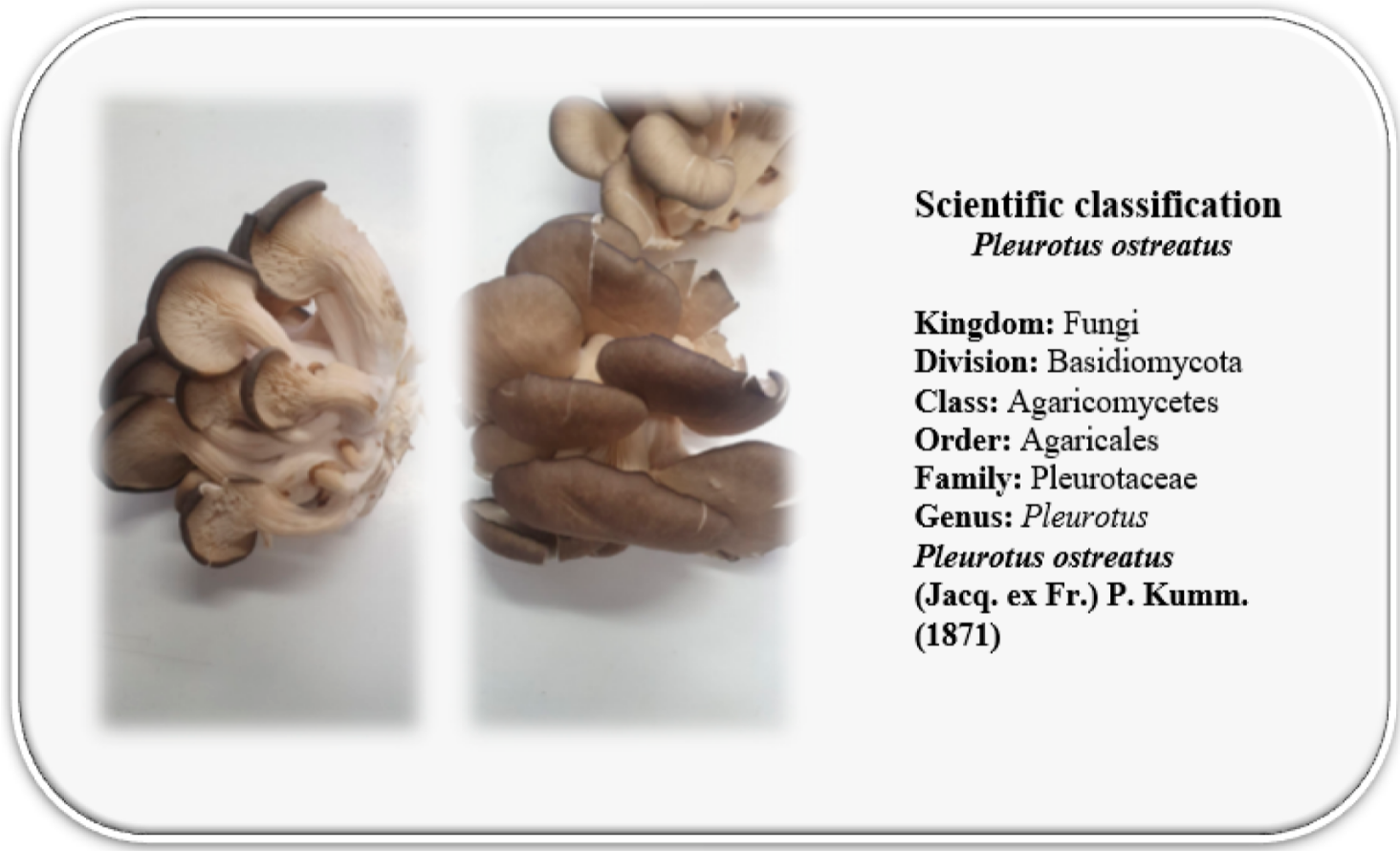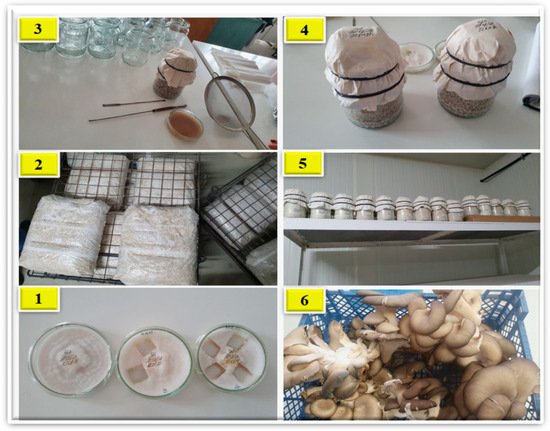The field of biotechnology presents us with a great chance to use many organisms, such as mushrooms, to find suitable solutions for issues that include the accumulation of agro-wastes in the environment. The green biotechnology of mushrooms (Pleurotus ostreatus L.) includes the myco-remediation of polluted soil and water as well as bio-fermentation. The circular economy approach could be effectively achieved by using oyster mushrooms (Pleurotus ostreatus L.), of which the substrate of their cultivation is considered as a vital source for producing biofertilizers, animal feeds, bioenergy, and bio-remediators. Spent mushroom substrate is also considered a crucial source for many applications, including the production of enzymes (e.g., manganese peroxidase, laccase, and lignin peroxidase) and bioethanol. The sustainable management of agro-industrial wastes (e.g., plant-based foods, animal-based foods, and non-food industries) could reduce, reuse and recycle using oyster mushrooms.
1. Introduction
Green biotechnology is the use of scientific techniques and tools, including molecular markers, genetic engineering, molecular diagnostics and tissue culture, on plants; it is called red biotechnology in the medical field and white biotechnology in the industrial field
[1]. Fungi have several applications in agricultural and environmental sustainability, which can support the growth of plants, such as mycorrhizal association
[2], for human nutrition, including edible mushrooms
[3][4]. Arbuscular mycorrhizal fungi can also be utilized to sustain and improve soil health
[5]. Fungi, such as mushrooms, are important plants, which can be consumed due to their nutritional benefits (as edible mushrooms) and their medicinal values (as medicinal mushrooms) since time immemorial
[6]. Many applications of mushrooms were confirmed by researchers, such as their valuable biotechnological properties
[7][8], the sustainability of the mushroom industry through a zero waste and circular bioeconomy
[9], and myco-remediation
[10].
The genus
Pleurotus is considered as the second most cultivated and distributed edible mushroom all over the world after the champignon mushroom (
Agaricus bisporus), because of its adaptation capability
[11][12][13]. The mushrooms of
Pleurotus are characterized by several valuable medical, biotechnological, and nutritional attributes. Numerous studies have reported the many relevant features of the
Pleurotus genus, which confirmed their attractive low-cost industrial tools that resolve the pressure of ecological issues
[7][11][12][14][15][16][17]. These issues may include the production of enzymes (oxidases and hydrolases) and biomass from fruit residues using
Pleurotus spp.
[18], bioethanol production
[19], the biodegradation of pollutants
[20][21], and medicinal attributes
[6]. This genus is also characterized by its high content of fatty acids, steroids, and polysaccharides, which can produce a lot of bioactive molecules and has become a popular functional food
[15]. Additionally, a number of
Pleurotus species are highly adaptive, possess specific resistance to pests and polluted diseases, and they do not require any specific conditions for their growth
[7].
P. ostreatus is an important member of the
Pleurotus species, which has significant medicinal importance and nutritional values
[22] due to its anti-oxidative, anti-carcinogenic, anti-inflammatory, anti-hypercholesteremic, anti-viral, and immune-stimulating properties
[11].
2. The Genus Pleurotus and Its Potential Uses
2.1. Taxonomy and Botanical Description
The Pleurotus species belongs to the Kingdom of Fungi, Phylum of Basidiomycota, Class of Agaricomycetes, Order of Agaricales, Family of Pleurotaceae, and the Genus of Pleurotus
[23] (
Figure 1).
Pleurotus species, such as many species of mushrooms, include cultivated and wild mushrooms, which are dominant in many forests worldwide.
Pleurotus was first scientifically described in 1775 and, in 1871, the German mycologist Paul Kummer transferred the oyster mushroom to the genus
Pleurotus. This is a new genus defined by Kummer himself in 1871 and is the currently accepted scientific name.
Pleurotus ostreatus grows throughout the United Kingdom, Ireland, and most parts of Europe. It is also widely distributed in many parts of Asia, including Japan, and is located in parts of North America
[24].
Figure 1.
Photos of
Pleurotus ostreatus
and the scientific classification of this mushroom. (Photos were taken by Gréta Törős, Debrecen University, Hungary).
2.2. Food Importance of the Pleurotus Genus
The genus
Pleurotus includes more than 200 species, which are consumed worldwide as edible mushrooms with an annual increase of 15%, and
Pleurotus is considered as the second most commonly consumed mushrooms
[25]. Some representatives of this genus (e.g., the oyster mushroom or
P. ostreatus) are well known for their odor, flavor, nutraceutical value, and gastronomic properties, which are important to several consumers
[26]. Thus, the edible mushroom of
P. ostreatus has been used as a source of food additives due to its high content of antioxidants, bioactives, and β-glucans
[25][27]. Due to their contents of minerals, fibers, lipids, and vitamins,
Pleurotus mushrooms have become increasingly appealing as functional foods
[16]. Different species of
Pleurotus mushrooms and the chemical composition of their nutritional values, including moisture, proteins, carbohydrates, fats, ash and fiber, are presented in
Table 1. Based on this Table, the highest content of crude proteins (30 and 35.5%, respectively) was recorded for the
Pleurotus citrinopileatus and
P. djamor var. roseus mushrooms, whereas the
P. eryngii mushroom had the highest fiber content (28.29%).
Table 1. The nutritional content (as % or g/100 g of dried mushrooms) of some Pleurotus spp. mushrooms from different sources.
| Pleurotus spp. |
Moisture (%) |
Proteins (%) |
Carbohydrates (%) |
Fats (%) |
Ash (%) |
Fiber (%) |
Refs. |
| Pleurotus ostreatus |
90.7 |
18.3 |
71.25 |
2.58 |
7.82 |
14.31 |
[28] |
| Pleurotus eryngii |
91.0 |
11.9 |
39.85 |
7.50 |
4.89 |
28.29 |
[29] |
| Pleurotus eryngii |
88 |
20 |
53 |
2.8 |
7.5 |
7.5 |
[30] |
| Pleurotus eryngii |
88 |
18.8 |
57 |
2.3 |
5.5 |
10 |
[31] |
| P. citrinopileatus |
88.9 |
30.0 |
42.50 |
3.90 |
7.65 |
20.78 |
[32] |
| Vitamin E |
Lipid peroxidation is prevented in cell membranes |
[ | 43] |
Pleurotus flabellatus |
91.0 |
21.6 |
57.40 |
1.80 |
10.7 |
| Immuno-modulatory |
Polysaccharides |
The toxicity of cyclophosphamide in mice was decreased due to the immune-modulatory activity |
[43 | 11.90 |
] | [ | 33] |
| P. djamor var. roseus |
79.5 |
35.5 |
44.75 |
1.72 |
5.90 |
14.60 |
[34] |
| Anti-inflammatory |
Polysaccharides (β-glucans) |
Methotrexate may have a synergistic effect on the arthritis of rats |
[45] |
Pleurotus pulmonarius |
78.8 |
20.3 |
34.00 |
2.62 |
7.33 |
9.00 |
[ |
| Anti-hypercholesterolemic |
Statins (lovastatin) |
In the cholesterol synthesis pathway, 3-hydroxy-3-methyl-glutaryl coenzyme A reductase is inhibited due to the conversion of enzymes to mevalonic acid | 35 | ] |
| [ | 46 | ] |
Pleurotus djamor |
86.8 |
24.1 |
45.59 |
4.73 |
9.84 |
15.91 |
[36] |
| |
Flavons (chrysin) |
Non-enzymatic antioxidant parameters in hypercholesterolemic rats, the blood/serum levels of lipid profile parameters and hepatic marker enzymes decreased |
[47] |
Pleurotus tuber-regium |
87.1 |
22.1 |
63.03 |
1.06 |
2.97 |
10.86 |
[37] |
| Anti-cancer and anti-tumor |
Pleurotus florida |
87.5 |
20.5 |
42.83 |
2.31 |
9.02 |
11.50 |
[38] |
| Pleurotus sajor-caju |
87.0 |
24.6 |
39.82 |
2.29 |
8.28 |
10.90 |
[39] |
| Pleurotus cystidiosus |
91.1 |
15.6 |
55.92 |
2.05 |
6.30 |
20.05 |
[22] |
In 2017, the world production of
P. ostreatus was approximately 4.1 million tons. Similar to many oyster mushrooms,
P. ostreatus is cultivated for foods and medicinal purposes. It can be cultivated on different lignocellulosic substrates, including maize cobs, wheat straw, sawdust, or cotton waste
[40].
Pleurotus spp. can colonize and bio-degrade a large variety of lignocellulosic wastes, as a result of their ability to produce many ligninolytic enzymes
[40].
Pleurotus mushrooms have been used for their high nutritive content and their potential biotechnological and environmental applications.
2.3. Medicinal Importance of the Pleurotus Genus
This genus includes more than 40 species, commonly referred to as the “Oyster mushroom”, including
P. ostreatus and
P. eryngii, which has attracted special attention because of its high nutritional values and medicinal attributes
[11][12]. It is well known for its anti-oxidative, anti-carcinogenic, anti-inflammatory, anti-viral, anti-hypercholesteremic, and immune-stimulating properties, as well as its ability to regulate glucose levels and blood lipids
[11][12].
Table 2 lists the bioactive compounds and their activities, which are dominant in
Pleurotus ostreatus and their mode of actions or mechanisms
[41].
Table 2. Different bioactive compounds of Pleurotus ostreatus and their mode of actions.
| Activity |
Bioactive Compound |
Mode of Action |
Refs. |
| Anti-oxidative |
Lectins |
The dendritic cells were activated using the pathway of “Toll-like receptor 6 signal” |
[42] |
| |
Polysaccharides |
Increasing the activities of SOD, CAT, GST, GR, APx and reducing superoxide radicals, and the activity of GPx |
[43] |
| |
Phenols |
Inhibits the growth of HL-60 cells by inducing apoptosis |
[44] |
| |
Flavonoids, ascorbic acid and β-carotene |
Induces apoptosis by inhibiting HL-60 cell growth |
[44] |
| |
| Polysaccharides |
| In HeLa cell lines, cytotoxic activity inhibited the development of Ehrlich Tumor and Sarcoma 180 (S-180) |
| [ | 45 | ] | [48] |
| |
Pleuran (β-glucan) |
Anti-neoplastic properties of different cells (breast, colorectal and prostate cancers) |
[48] |
| |
Proteins |
In cell line SW 480, therapeutic effects on colorectal cancer and monocytic leukemia by inducing apoptosis |
[48] |
| |
Lectins |
Tumor burden in Sarcoma S180 reduced by 88.4% and hepatoma H-22 by 75.4% in mice; increase in survival time |
[45] |
| Anti-viral and anti-microbial |
Laccase |
Anti-viral effects against hepatitis C |
[48] |
| |
Ubiquitin-like protein |
Anti-viral effects in human immunodeficiency viruses, such as HIV-1 |
[45] |
| |
Nanoparticles mixed with aqueous extract |
Inhibiting the growth of Gram-negative bacteria |
[45] |
| |
Ribonucleases |
Degradation of viral genetic materials to neutralize HIV |
[49] |
| Hepatoprotective |
Poly-saccharopeptides |
Thioacetamide is alleviated, inducing alterations in inflammation, steatosis, fibrosis and necrosis |
[49] |
| Anti-aging |
Mushroom powder |
Significant bifidogenic and then strong lactogenic effects |
[50] |


